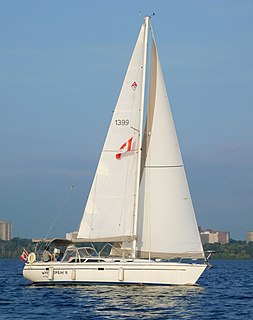Related Research Articles

The Hunter 386 is an American sailboat, that was designed by the Hunter Design Team and first built in 1999.
The Hunter 290 is an American sailboat that was designed by the Hunter Design Team as a cruising boat and first built in 1999.
The Hunter 320 is an American sailboat that was designed by the Hunter Design Team and first built in 2000.
The Hunter 326 is an American sailboat that was designed by Glenn Henderson for cruising and first built in 2001.
The Hunter 376 is an American sailboat that was designed by the Hunter Design Team as a cruiser and first built in 1996.
The Hunter 38 is an American sailboat that was designed by Glenn Henderson as a cruiser and first built in 2004.
The Hunter 430 is an American sailboat that was designed by the Hunter Design Team as a cruising boat and first built in 1995.
The Hunter 456 is an American sailboat that was designed by the Hunter Design Team as a cruiser and first built in 2003.
The Hunter 466 is an American sailboat that was designed by the Hunter Design Team as a cruiser and first built in 2002.
The Hunter 49 is an American sailboat that was designed by Glenn Henderson and the Hunter Design Team as a cruiser and first built in 2007.
The Marlow-Hunter 50 Center Cockpit, also called the Marlow-Hunter 50CC is an American sailboat that was designed by the Hunter Design Team as a cruiser and first built in 2010.
The Marlow-Hunter 31 is an American sailboat that was designed by Glenn Henderson as a cruiser and first built in 2015.
The Marlow-Hunter 37 is an American sailboat that was designed by Glenn Henderson as a cruiser and first built in 2014.
The Freedom 25 is an American sailboat that was designed by Gary Hoyt as a single-handed racer-cruiser and first built in 1980.
The S2 9.2 is an American sailboat that was designed by Arthur Edmunds as a cruiser and first built in 1977.
The Island Packet 29 is an American sailboat that was designed by Robert K. Johnson as a cruiser and first built in 1981.
The Island Packet 35 is an American sailboat that was designed by Robert K. Johnson as a cruiser and first built in 1988.

The Catalina 36 is a family of American sailboats that was designed by Frank Butler and Gerry Douglas for cruising and first built in 1982. A Mark II version was introduced in 1994 and produced until 2005.
The Southern Cross 35, also called the Gillmer 35, is an American sailboat that was designed by Thomas C. Gillmer as a cruiser and first built in 1978.

The Eagle 38 is a Dutch sailboat that was designed by Hoek Design as a day sailer and first built in 2019.
References
- 1 2 3 4 5 Browning, Randy (2019). "Catalina 375 sailboat specifications and details". sailboatdata.com. Archived from the original on 30 June 2019. Retrieved 3 July 2019.
- ↑ Browning, Randy (2019). "Gerry Douglas". sailboatdata.com. Archived from the original on 30 June 2019. Retrieved 30 June 2019.
- ↑ Browning, Randy (2019). "Catalina 36 Mk II sailboat specifications and details". sailboatdata.com. Archived from the original on 30 June 2019. Retrieved 4 June 2019.
- 1 2 3 4 Pillsbury, Mark (27 May 2008). "Catalina 375". Cruising World. Archived from the original on 29 March 2016. Retrieved 3 July 2019.
- 1 2 3 Sail Staff (8 December 2008). "Boat Review: Catalina 375". Sail magazine. Archived from the original on 4 July 2019. Retrieved 3 July 2019.
- 1 2 Perry, Robert H. (2019). "Catalina 375". Sailing Magazine. Archived from the original on 10 September 2015. Retrieved 3 July 2019.